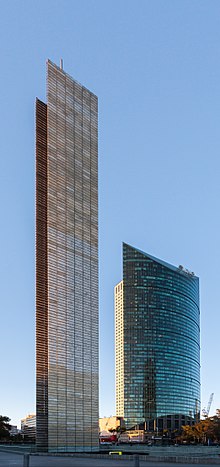
Managua is the capital and largest city of Nicaragua, and the center of an eponymous department. Located on the southwestern shore of Lake Managua and inside the Managua Department, it has an estimated population of 1,055,247 in 2020 within the city's administrative limits and a population of 1,401,687 in the metropolitan area, which additionally includes the municipalities of Ciudad Sandino, El Crucero, Ticuantepe and Tipitapa.

Valparaíso is a major city, seaport, naval base, and educational centre in the commune of Valparaíso, Chile. "Greater Valparaíso" is the second largest metropolitan area in the country. Valparaíso is located about 120 km (75 mi) northwest of Santiago by road and is one of the Pacific Ocean's most important seaports. Valparaíso is the capital of Chile's second most populated administrative region and has been the headquarters for the Chilean Navy since 1817 and the seat of the Chilean National Congress since 1990.

Antigua Guatemala, commonly known as Antigua or La Antigua, is a city in the central highlands of Guatemala known for its centuries-old architecture and ruins. It has been designated a UNESCO World Heritage Site, featuring Spanish Baroque-influenced buildings.

Aguascalientes is the capital of the Mexican state of Aguascalientes and its most populous city, as well as the head of the Aguascalientes Municipality; with a population of 934,424 inhabitants in 2012 and 1,225,432 in the metro area. The metropolitan area also includes the municipalities of Jesús María and San Francisco de los Romo. It is located in North-Central Mexico, which roughly corresponds to the Bajío region (Lowlands) within the central Mexican plateau. The city stands on a valley of steppe climate at 1880 meters above sea level, at 21°51′N102°18′W.
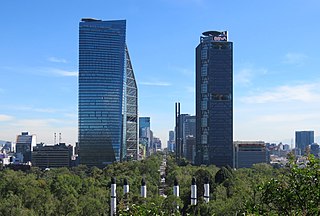
Paseo de la Reforma is a wide avenue that runs diagonally across the heart of Mexico City. It was designed at the behest of Emperor Maximilian by Ferdinand von Rosenzweig during the era of the Second Mexican Empire and modeled after the great boulevards of Europe, such as the Ringstraße in Vienna and the Champs-Élysées in Paris. The planned grand avenue was to link the National Palace with the imperial residence, Chapultepec Castle, which was then on the southwestern edge of town. The project was originally named Paseo de la Emperatriz in honor of Maximilian's consort Empress Carlota. After the fall of the Empire and Maximilian's subsequent execution, the Restored Republic renamed the Paseo in honor of the La Reforma.

Cuernavaca is the capital and largest city of the state of Morelos in Mexico. The city is located around a 90-minute drive south of Mexico City using the Federal Highway 95D.

Popayán is the capital of the Colombian department of Cauca. It is located in southwestern Colombia between the Western Mountain Range and Central Mountain Range. It has a population of 318,059 people, an area of 483 km2, is located 1760 meters above sea level, and has an average temperature of 18 °C.

The Mexico City Metro is a rapid transit system that serves the metropolitan area of Mexico City, including some municipalities in Mexico State. Operated by the Sistema de Transporte Colectivo (STC), it is the second largest metro system in North America after the New York City Subway. In 2019, the system served 1.655 billion passengers, the tenth highest ridership in the world.

Saint-Jean-de-Luz is a commune in the Pyrénées-Atlantiques department, southwestern France. Saint-Jean-de-Luz is part of the Basque province of Labourd (Lapurdi).

The Ávila Adobe, built in 1818 by Francisco Ávila, is the oldest standing residence in the city of Los Angeles, California. Avila Adobe is located in the paseo of historic Olvera Street, a part of the Los Angeles Plaza Historic District, a California State Historic Park. The building itself is registered as California Historical Landmark #145, while the entire historic district is both listed on the National Register of Historic Places and as a Los Angeles Historic-Cultural Monument.
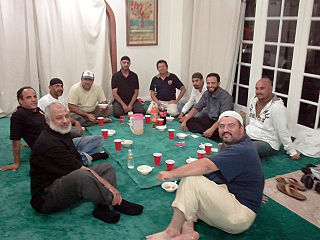
Mexico is a predominantly Christian country, with adherents of Islam representing a small minority. Due to secular nature of the Mexico's constitution, Muslims are free to proselytize and build places of worship in the country. The country has a population of around 126 million as of 2020 census and according to Pew research center, the Muslim population was 90,000 in 1990, 911,000 in 2010, and is predicted to be 998,000 in 2030; however, according to the 2010 National Institute of Statistics and Geography (INEGI) census, there were only 19,500 individuals who identified Islam as their religion. Most Muslims are foreign nationals and the majority are Sunni with a sizeable Ahmadiyya community.

The Minor Basilica of San Sebastian, better known as San Sebastian Church or San Sebastian Basilica is a minor basilica of the Roman Catholic Church in Manila, Philippines. It is the church of the Parish of San Sebastian, and also a Shrine of Nuestra Senora del Monte Carmelo, or Our Lady of Mount Carmel.
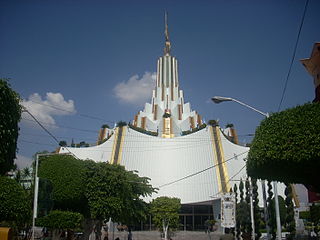
The Iglesia del Dios Vivo, Columna y Apoyo de la Verdad, La Luz del Mundo —or simply La Luz del Mundo (LLDM)—is a nontrinitarian Christian denomination with international headquarters in Guadalajara, Jalisco, Mexico. La Luz del Mundo practices a form of restorationist theology centered on three leaders: Aarón—born Eusebio—Joaquín González (1896–1964), Samuel Joaquín Flores (1937–2014), and Naasón Joaquín García, who are regarded as modern-day apostles of Jesus Christ.

Colonia Santa María la Ribera is a colonia located in the Cuauhtémoc borough of Mexico City, just west of the historic center. It was created in the late 19th century for the affluent who wanted homes outside of the city limits. The colonia reached its height between 1910 and 1930. In the 1930s, the middle class moved in and a new era of construction began. The colonia began to deteriorate in the 1950s, as the city grew around it and apartment buildings were constructed. Since the 1985 Mexico City earthquake, poorer residents have moved in and economic housing has been constructed. Today, the colonia is a mix of old mansions and homes, small shops and businesses, tenements and abandoned buildings. The colonia has one major park and two museums. This area was designated as a "Barrio Mágico" by the city in 2011.

Mexico City Metro Line 1 is one of the twelve metro lines operating in Mexico City, Mexico. Officially inaugurated in 1969, it went to become the first metro line to be built in the country. Its identifying color is pink and it runs through the city from west to east.
The following is a timeline of the history of the city of Chihuahua, Mexico.
The Fort of San Diego, formerly also known as the Fort of San Carlos is a star fort in Acapulco, Guerrero, Mexico. It was built by the Spanish Empire, and it was one of the most important Spanish fortifications along the Pacific coast. The fort was first built in the 17th century, but was completely rebuilt in the 18th century. Today, it is an important landmark in Acapulco, and it is open to the public as the Acapulco Historic Museum.

The Centre of Digital Culture is a multifuncional cultural complex in Mexico City with the vocation to activities of digital art, as well as the promotion of "expressive forms in the digital world" and "his influence in the cultural and artistic life of the country". It was inaugurated on September 16, 2012. The center belongs to Secretariat of Culture. The cultural centre was built under the Estela de Luz.
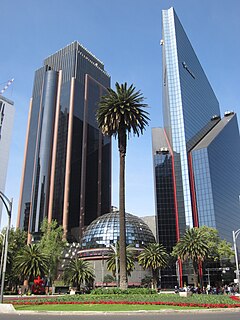
Glorieta de la Palma is a roundabout in Mexico City that connects Paseo de la Reforma with Río Rhin Street and Niza Street. It is known for its tall palm tree that stood in the middle for a century. The roundabout is the only one along Reforma that has never had a monument. The building of Bolsa Mexicana de Valores is at the roundabout, opposite the Zona Rosa. The area is serviced by the city's Metrobús system at La Palma station, whose pictogram features the palm tree.

The Memorial to Victims of Violence in Mexico is a memorial in Chapultepec, Mexico City. Its construction started in 2012 during the presidency of Felipe Calderón and it was opened on 5 April 2013, during the presidency of his successor, Enrique Peña Nieto. As its name indicates, it was dedicated to honoring those who have suffered violence in the country.
